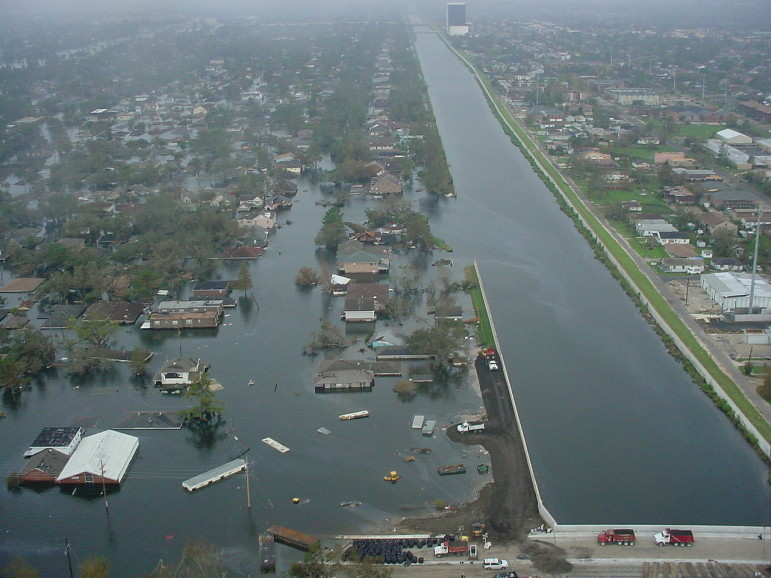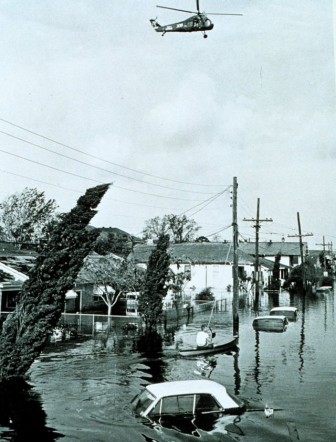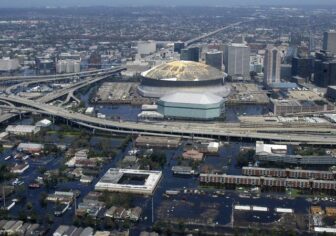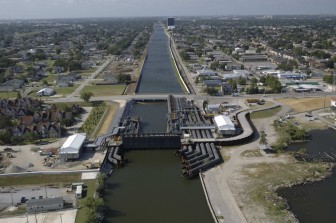
In the rush to rebuild after Hurricane Katrina, Congress told the Corps of Engineers to raise the levees and floodwalls around New Orleans to protect against a 100-year storm. There was one problem: That was weaker than what Congress ordered 50 years ago.
As the U.S. Army Corps of Engineers puts the finishing touches on its new, $14.5 billion storm protection system for New Orleans, agency and local officials see the best protection the city has ever had.
But some engineers and storm experts familiar with the system’s history see something else. Something less.
They see a system that after Hurricane Katrina was downgraded by Congress from one that had to be strong enough to repel the “most severe” storm to one that only had to qualify for flood insurance, a much lower standard.
Live chat, noon CT Friday: Discuss this story with Bob Marshall and Tulane’s Mark Davis
“It’s as if your poorly built, three-story house collapsed, so the contractor said, ‘Ok, I’ll replace it with a well-made, two-story house,’” said Mark Davis, director of the Tulane Institute on Water Resources Law & Policy.
“The corps has rebuilt a system to a lower standard of protection than its poorly built system that collapsed during Hurricane Katrina,” Davis said.
“Now, is what they built a good system, better than what it replaced? Yes, no question. But is it adequate? No, not given what’s at risk here. And does it meet that original standard ordered in 1965? No.”—Bob Jacobsen, engineer
Is the storm protection system around New Orleans better than the old one? “Absolutely,” Davis said. “Is it what we were supposed to have? No.”
That shift has had two important effects, Davis and others say:
It lowered the design height of walls defending a city located on a sinking delta during an age of rising sea levels.
And it changed the purpose of the system from protecting lives to protecting property – a lesser challenge for designers.
“That’s what Congress did” in directing the corps to build to a lesser standard, Davis said, “and that’s not what the law says they must do. People should be asking the city, the state, and their representatives in Congress how this happened. Someone should be telling that story.”
Congress tells corps to guard against ‘most severe’ storm that could be expected

It’s a story about an agency’s reluctance to change course, a Congress on a budget-cutting mission and a city in a hurry to recover from disaster.
It begins in 1965 when Congress, alarmed by the devastation Hurricane Betsy caused in and around New Orleans, passed a bill authorizing the Lake Pontchartrain and Vicinity Hurricane Protection Project – Public Law 89-298.
According to the law, the system was supposed to be strong enough to repel a storm consisting of “the most severe combination of meteorological conditions that are considered reasonably characteristic of the region.”
That language comes from a government report that defined the Standard Project Hurricane, a model storm used by the Corps of Engineers to determine the height of the walls and levees around New Orleans.
The corps said such a storm would be so severe it was likely to occur only once every 200 years along the Louisiana coast.
The law was amended seven times from 1974 to 2000, but the standard of protection was never changed.
Forty years later, what the corps had built failed during Katrina, suffering about 50 breaches. Most were not the result of levees being overwhelmed by storm surge. More than 1,500 people were killed.
New research, same tactics
Post-disaster investigations catalogued a long list of engineering mistakes and errors in judgment by the corps that contributed to the disaster.
One of the most troubling was the refusal by corps officials to upgrade their design as new information indicated that land was sinking faster and storms could be worse than originally predicted.
Even when new data increased the threat in the definition of the “most severe conditions,” the corps claimed that the project could continue to use the standard set forth in 1965.
//
That happened at least twice.
In 1979 the National Weather Service alerted the corps to new research that showed the Standard Project Hurricane could be worse than previously expected.
The corps had originally described the model storm as a fast-moving Category 3 on the Saffir-Simpson scale. In 2006 Louisiana hurricane experts said the increases would make the Standard Project Hurricane at least a Category 4.
The corps never bumped up its specifications to account for the increased threat.
Indeed, an analysis conducted of project decisions by the Corps of Engineers in 2008 admits this was a grievous misstep, saying the decision meant the system no longer provided surge protection for the Standard Project Hurricane, a 200-year storm.
In 1985, the National Geodetic Survey told the corps that a new method of measuring elevation showed that its prior elevations were up to two feet lower than it had thought.
Due to subsidence over the years, walls and levees that were supposed to be 14 feet above sea level might only be 12 feet. But the engineer in charge told his staff to continue using the old measurement system because that was the one in use in 1965, when the project was authorized by Congress.
The corps’ 2008 internal review of the storm protection system noted that the agency continued to report that the project would protect against the Standard Project Hurricane — the 200-year storm — “even though the datum error and benchmark decision made that unlikely.”
Critics have long been frustrated by the corps’ habit of blindly following Congress’ initial orders rather than lobbying for improvements to deal with new information. It’s true, Davis said, that the corps can only act when Congress passes a law and funds the job. But he argued that the agency has the leeway to adapt to changing circumstances.
In fact, in 1965 the first corps’ first project directors increased the design specifications of the hurricane protection system based on Hurricane Betsy, which showed that storm surge could be higher than expected. The authorization, wrote a corps official, “is broad enough to allow reconsideration of the degree of protection.”
But fellow corps employees, as well as the agency’s 2008 review, said later that they were under pressure to keep costs down and finish projects on time. So they didn’t strengthen the system.
Even today, corps officials point to that 1965 legislation as a constraint.
Ken Holder, chief of public affairs of the corps’ New Orleans district, said the original system could be built only to “reduce the damage from a specifically selected ‘Design Hurricane’ with the specific characteristics” outlined in the law.
Time line
Corps gets new marching orders after Katrina
As Congress began looking at rebuilding the system after Katrina, the Standard Project Hurricane gained renewed attention.
Considering that Katrina — a Category 3 storm — had destroyed the old system, the city and state pushed for Category 5 protection. But the George W. Bush administration — and some members of Congress — didn’t like the costs.

Barely two months after the disaster, the president’s head of the rebuilding effort, Donald Powell, put the Category 5 idea to rest, saying, “The commitment is to build the levees back to a 3 … and then to study the 5.”
But when Congress authorized the rebuilding of the system two years later in the 2007 Water Resources Development Act, it didn’t mention hurricane intensity or the Standard Project Hurricane.
Instead the corps was told to raise walls and levees to the level of protection necessary to participate in the National Flood Insurance Program.
A system that once was supposed to defeat the “most severe meteorological conditions” would now be replaced by one that only had to be good enough to secure flood insurance — protection from a so-called 100-year flood. (A 100-year flood is a storm that has a 1 percent chance of happening in any year, not a storm that occurs once a century.)
200-yearDesign standard for hurricane protection system before Katrina100-yearDesign standard for system after Katrina
Political leaders and others involved in the post-Katrina negotiations say there were two major drivers for the sudden change: money and the urgent need to regain flood insurance.
“It was always about money with the Bush people,” recalled Kathleen Blanco, Louisiana’s governor at the time. “Everyone remembers when the president came down and said he was going to make it right, build it back better and stronger. And I think he really meant that.
“But then when the corps started putting the numbers together, the administration was just not going to go there.”
Sen. Mary Landrieu, D-La., was one of the leading voices at the time for Category 5 protection. Her staff declined repeated requests for an interview, instead providing The Lens with a statement that didn’t address our questions.
Davis, who was involved in post-storm planning as the head of the Coalition to Restore Coastal Louisiana, said getting insurance quickly was paramount.
“There could be no rebuilding or attracting and keeping businesses without flood insurance,” he said. “There was an urgency, almost a panic, over the issue.” Building to the lower standard was not only cheaper, but faster.
Even built to lower standard, new system is better than old one
Local corps officials say the current 100-year system is built to more demanding specifications than those laid out 1965 for a 200- or 300-year storm.
Critics agree, but say those improvements don’t measure up to what science now knows would be the “most severe conditions” that can reasonably be expected in this region — storms worse than Katrina.
Bob Jacobsen, an engineer who completed an in-depth evaluation of the new system for the local Flood Protection Authority, said there’s “no question” the new system is a lower standard of protection than that 1965 charge demanded.

“Now, is what they built a good system, better than what it replaced? Yes, no question,” he said. “But is it adequate? No, not given what’s at risk here.
“And does it meet that original standard ordered in 1965? No.”
How much higher would the flood protection system need to be to protect against the “most severe storm”? Engineers say it’s hard to quantify.
The heights of levees and floodwalls ringing the metro area are not uniform because computer models have shown storm surge levels would be different at each location.
For example, some sections of levee along Lakeshore Drive are 16 feet above sea level; others along the Gulf Intracoastal Waterway are 21.5 feet.
With that variability in mind, Jacobsen estimated 500-year protection would require an additional 1 to 2 feet along the entire system, without accounting for the added height of wind-driven waves.
“If you add in wave conditions, in some areas you might be talking about needing 3 to 4 feet higher,” Jacobson said.
The switch to the flood-insurance standard has had another, equally troubling effect, critics said, because a system designed to protect people would be more robust than one built to save property.
“In effect, it’s not really a standard that’s been set for safety reasons, it’s a standard that’s been set for obtaining affordable flood insurance only,” said Bob Turner, an engineer who is the regional director of the Southeast Louisiana Flood Protection Authority-East.
“The system should be based on protecting what’s at risk, and in a highly populated urban area, that is something much greater than the cost of property damage,” Turner stressed.
Current system can be strengthened, but is it enough?
The corps and the Flood Protection Authority say the current system can be brought to what is considered a “resiliency level” of 500-year protection – meaning the walls and levees would stand up even if they were overtopped by something stronger than a 100-year storm.
This could be done by armoring — with grass or synthetic mats — the side of earthen levees facing the city.
But Rick Luettich, a noted storm surge modeler and a member of the local Flood Protection Authority board, said this isn’t the same as building the system New Orleans needs. A 100-year system with resilience added does not provide the same level of confidence as a system built to a 500-year standard, he said.
“It’s sort of back-engineering,” he said. “Up-front it should have a much higher design standard applied to it. And in the long run that’s what you want for this area. I’ve always said that, and I still believe that. ”
Leuttich and Turner also point to research that shows the onset of global warming is likely to result in more large storms.
A recent review of the new hurricane protection system raised many of the same criticisms, including an overemphasis on protecting property, not people.
Geographer Ezra Boyd of DisasterMap.net coordinated the report.* He pointed to a study by noted Dutch engineers who said the life and property at risk in New Orleans warrant 1,000- to 4,000-year protection.
The Dutch system, in contrast, uses a standard of 10,000 years in vulnerable areas — 100 times more robust than the one nearing completion around New Orleans.
Local corps officials said even if they had the freedom to strengthen the levee system, their 2007 marching orders superseded the 1965 instructions. And while that authorization remains open, they said, Congress would have to provide new orders and funding.
Davis said the corps’ argument “might be right in a law-school debating sense” but it misses the intent of Congress in 1965, and that law remains on the books.
He contends the city should take its case to court to argue that Congress has not lived up to the 1965 standard. The 2007 orders “were a detour, not a redirection,” he argued.
As sea levels rise and the city becomes more exposed, people will not want to move to New Orleans, Davis said.
“A major metro area that has only a razor-thin commitment with insurability is one that is gambling with its future,” he said. “In 1965 Congress said we needed and deserved a level of protection to meet those risks. We still do today.”
*Correction: This story originally identified Ezra Boyd as an engineer; he’s a geographer. (May 15, 2014)



Dallas, Kansas City, St. Louis and Tacoma all have 500-year protection.
In addition to all the shortcomings cited there is the IPET’s finding that the flood protection “system” performed as a “system in name only”. Since no actions have been taken by Congress, the Corps, the local levee authorities or the state to introduce best systems practices, it would be fair the conclude that the new “system” remains a system in name only.
If someone had cared to employ a systems approach they would have taken a holistic (integrated) perspective to all aspects of the flooding problem to include elevation of residences and ground water retention. Instead, community elements that have a narrow, short-term and profit-oriented approach which ignores resident safety by degrading obvious threats and risks.
Congress and their lackey, the Corps have taken a similar but not unexpected stance of being driven by cost and not safety. The Corps bears an added burden in that many officers and civil servants are members of the American Society of Civil Engineers who’s professional ethical standards bind them, by oath, to hold safety “paramount”. In this, the ASCE has forfeited the trust of the American people by not hold Corps activities and members to this high standard.
Furthermore, ASCE has published engineering guidance stating that levees are never enough and must be considered with non-structural measures such as zoning, ground water management and elevation
Here is the Corps guidance on levees alone
http://content.asce.org/files/pdf/SoYouLiveBehindLevee.pdf
Once you get into putting a finite number on safety you in a lose/lose condition. Civil Engineers are expect by their ethics code and at least commercial customers to establish what properties are “safe enough”. That’s why commercial clients sue Professional Engineers when safety is inadequate.
If only they were liable for adequate flood safety we could replace direct flood insurance with professional engineer liability insurance. The coast would be passed on to property owners but at least we replace politics with engineering competence.
What a crock! The SLFPA-E has finally been shown for the farce that it really is. The stuff in this article isn’t new. Its been around since 2007. The leaders of the SLFPA-E intentionally chose not to review the work of the Corps and just go along with the program. How many times over the years did you see and hear Doody, Barry and the leaders of the Corps say how good the system was when they know they didn’t even look at the data not even one time. We have another system in name only (ASINO). What all of these experts are not saying is how poorly the selected storms represent our actual threat. We didn’t have 152 storms modeled. We had multiple storms run on the same paths over and over to get up to 152 storms.
Now the SLFPA-E wants to sue the oil and gas companies and control the restoration of our coastal line of defense – NO THANKS! They already showed me they weren’t up to the first task so why should I give them anything additional and so critical. Doody, Barry and the rest of the SLFPA-E and its staff of engineers at the OLD should be run out of town for allowing this farce to occur. Just show me one review by one commissioner in the past 7-1/2 years that demonstrates their professional backgrounds were used to review the Corps’ work. SHAM!
So true. If they wanted to do this thing right they would have restoreed the coast at the same time the levees were being rebuilt. What good is talking about muliple lines of defense if they don’t get funded, designed or constructed. It was just part of the side show put on by the Corps and the SLFPA-E.
Jacobsen said the new system is better than the old one. The old one failed. Anything would have been better than a failure. Even Duck Tape – wait didn’t the Corps use that and newspaper in the floodwalls.
Turner said the system was built for getting flood insurance not flood threats. I wish this would have been made more public at the SLFPA-E meetings. The SLFPA-E board members like Doody and Barry made the public believe it was built for flood protection and according to Barry and Doody it was “state of the art”, “the best in the world”, “world class”, “the new floodwalls were built right” (Barry said on the Rachel Maddow Show) etc . I guess that’s what we get when we put a CPA and an ex-football coach in charge and deem them “flood experts”, and “founding fathers of modern flood prortection”, and kept the same individuals on staff in the levee districts that watched the inferior systems be constructed in Orleans Parish and give them promotions and somehow think they would somehow get it right this time.
Excellent article. It is plainly obvious that it is going to take every dollar we can get to maintain and improve the flood protection infrastructure we have in place. Dollars that are currently being wasted designing river diversions miles downstream from the levees should be used on levee improvement projects.
Starting replenishing sediment to the wetlands, stop pumping groundwater out. The Dutch solution needs to be pursued, and politicians who stand in the way of that need to be removed from office, or there will be no hope.
The thought of treating our flood risk as an integrated system using multiple lines of defense is beyond the intellectual and experiential capability of the state, local and federal flood protection communities.
The Corps treated the AISINO finding by disestablishing an internal working group on systems approaches. Civil Engineers don’t do real systems. In contrast the rest of DOD went to systems engineering in the 60s the results of which have been successfully demonstrated on recent battlefields.
Multiple lines of defense come from ancient military approaches to ensuring defenses are resilient – take a licken’ and keep on ticken’. The old belt and suspenders rule for keeping your pants up. I’ve been told by Corps personnel that Congress doesn’t allow any form of redundant protect even it’s engineered to provide “acceptable” protection. Congress playing junior engineer.
The root cause of our problems include using political beauty contests to over ride sound, safety-first engineering. The engineering profession is complicit by putting code compliance above responsible professional engineering. Replace flood insurance with professional engineering liability insurance. That dramatically prevent future flood losses. Get government and special interest politics (GNOInc) out of it.
How could this have happened under the watchful eye of our new ‘reformed’ levee board? Where is the oversight that they were supposed to have provided?
They were too busy watching the cashflow enrichen the favored few to look at details like storm surges an levee designs.